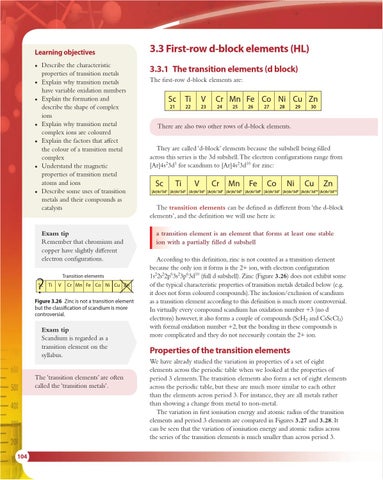Learning objectives
3.3 First-row d-block elements (HL)
r Describe the characteristic
3.3.1 The transition elements (d block)
properties of transition metals r Explain why transition metals have variable oxidation numbers r Explain the formation and describe the shape of complex ions r Explain why transition metal complex ions are coloured r Explain the factors that affect the colour of a transition metal complex r Understand the magnetic properties of transition metal atoms and ions r Describe some uses of transition metals and their compounds as catalysts
Exam tip Remember that chromium and copper have slightly different electron configurations.
? Sc
Transition elements Ti
V
Cr Mn Fe Co Ni Cu Zn
Figure 3.26 Zinc is not a transition element but the classification of scandium is more controversial.
Exam tip Scandium is regarded as a transition element on the syllabus. The ‘transition elements’ are often called the ‘transition metals’.
104
The first-row d-block elements are:
Sc 21
Ti
V
22
23
Cr Mn Fe Co Ni Cu Zn 24
25
26
27
28
29
30
There are also two other rows of d-block elements. They are called ‘d-block’ elements because the subshell being filled across this series is the 3d subshell. The electron configurations range from [Ar]4s23d1 for scandium to [Ar]4s23d10 for zinc:
Sc
Ti
V
Cr
Mn
Fe
Co
Ni
Cu
Zn
[Ar]4s23d1 [Ar]4s23d2 [Ar]4s23d3 [Ar]4s13d5 [Ar]4s23d5 [Ar]4s23d6 [Ar]4s23d7 [Ar]4s23d8 [Ar]4s13d10 [Ar]4s23d10
The transition elements can be defined as different from ‘the d-block elements’, and the definition we will use here is: a transition element is an element that forms at least one stable ion with a partially filled d subshell According to this definition, zinc is not counted as a transition element because the only ion it forms is the 2+ ion, with electron configuration 1s22s22p63s23p63d10 (full d subshell). Zinc (Figure 3.26) does not exhibit some of the typical characteristic properties of transition metals detailed below (e.g. it does not form coloured compounds).The inclusion/exclusion of scandium as a transition element according to this definition is much more controversial. In virtually every compound scandium has oxidation number +3 (no d electrons) however, it also forms a couple of compounds (ScH2 and CsScCl3) with formal oxidation number +2, but the bonding in these compounds is more complicated and they do not necessarily contain the 2+ ion.
Properties of the transition elements We have already studied the variation in properties of a set of eight elements across the periodic table when we looked at the properties of period 3 elements. The transition elements also form a set of eight elements across the periodic table, but these are much more similar to each other than the elements across period 3. For instance, they are all metals rather than showing a change from metal to non-metal. The variation in first ionisation energy and atomic radius of the transition elements and period 3 elements are compared in Figures 3.27 and 3.28. It can be seen that the variation of ionisation energy and atomic radius across the series of the transition elements is much smaller than across period 3.
